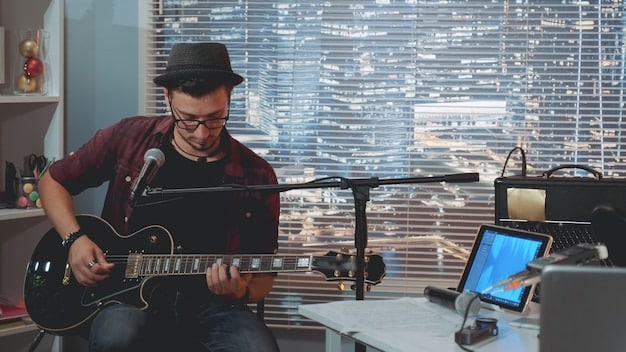How to Get Your Music Featured in US Film and TV: A Step-by-Step Guide

Getting your music featured in US film and TV involves strategic steps like preparing high-quality recordings, understanding licensing agreements, networking with music supervisors, and leveraging online platforms.
Are you a musician dreaming of hearing your song in a hit TV series or a blockbuster movie? The journey of securing a placement in the US film and TV industry can seem daunting, but with the right approach, it’s entirely achievable. This guide will break down the process, offering a step-by-step overview of how to get your music featured in US film and TV.
Understanding the US Film and TV Music Landscape
Before diving into the specifics, it’s crucial to grasp the dynamics of the US film and TV music market. This involves knowing the key players, understanding the types of music they seek, and recognizing the legal framework governing music use in these mediums. Developing this foundational knowledge is key to understanding how to get your music featured in US film and TV.
Key Players in Music Placement
Navigating the film and TV music industry requires knowing who makes the decisions. Here are some of the most important figures:
- Music Supervisors: These professionals are the gatekeepers, responsible for selecting and licensing music for films and TV shows. They work closely with directors and producers to find the perfect sonic accompaniment for each scene.
- Production Companies: Companies like Netflix, HBO, and independent film studios all have different music needs and approaches. Researching their past projects can provide insights.
- Music Publishers: Many composers and songwriters are affiliated with music publishers who actively pitch their catalogs to supervisors.
- Licensing Agencies: These agencies specialize in representing artists and negotiating music licenses for various uses.
Understanding the roles and preferences of these individuals will greatly enhance your chances of success. Networking and building relationships with them can open doors to opportunities you might not otherwise find.
Types of Music Commonly Used
The music used in film and TV varies widely depending on the genre, mood, and scene requirements. Common categories include:
- Original Songs: These are full-length songs, often featured during key scenes or in the opening/closing credits.
- Instrumental Scores: These provide background music and underscore the emotional tone of a scene.
- Source Music: This is music that originates from within the scene itself, such as a radio playing in a car or a band performing in a bar.
- Covers and Reinterpretations: Familiar songs performed in new ways can add a fresh perspective to a scene.
Tailoring your music to fit these categories can increase its appeal to music supervisors. Consider creating instrumental versions of your songs or experimenting with different genres to broaden your portfolio.
In conclusion, grasping the nuances of the US film and TV music landscape is the first essential step. Knowing the roles of key players and the types of music they seek will help you to effectively understand how to get your music featured in US film and TV.

Preparing Your Music for Submission
Once you understand the landscape, the next step is to ensure your music is submission-ready. This involves not only having high-quality recordings but also properly preparing metadata and understanding licensing requirements. Attention to detail in this phase is fundamental for how to get your music featured in US film and TV.
High-Quality Recordings and Mixing
In the competitive world of film and TV music, audio quality is non-negotiable. Music supervisors often sift through hundreds of submissions, and poorly produced tracks are unlikely to make the cut. Invest in professional recording and mixing to ensure your music sounds its best.
Even if you have a home studio, consider hiring a professional mixing engineer to give your tracks a polished sound. Focus on clarity, balance, and dynamic range to make your music stand out.
Metadata and Tagging
Metadata is the information embedded in your music files, including the song title, artist name, genre, and contact details. Proper metadata ensures that music supervisors can easily find and identify your music. Tagging your music correctly also helps in search algorithms.
Use industry-standard software to add metadata to your tracks, and be consistent in your formatting. Include keywords that accurately describe the mood, genre, and instrumentation of your music.
Understanding Licensing and Rights
Before you can license your music for film and TV, you need to understand the different types of rights involved. These include:
- Synchronization Rights: These rights allow the use of your music in synchronization with visual media.
- Master Rights: These rights pertain to the actual recording of your song.
- Performance Rights: These rights cover the public performance of your song.
Ensure you own or control all the necessary rights to your music before submitting it for consideration. If you’ve co-written a song or used samples, make sure you’ve obtained the appropriate clearances.
Preparing your music for submission is more than just having a great song; it’s about ensuring it’s professionally recorded, properly tagged, and legally cleared for use. This thoroughness is key for mastering how to get your music featured in US film and TV.
Networking and Building Relationships
In the entertainment industry, who you know often matters as much as what you know. Networking and building relationships with music supervisors, directors, and other industry professionals can greatly increase your chances of getting your music featured. Cultivating a professional network informs the process of how to get your music featured in US film and TV.
Attending Industry Events
Industry events like film festivals, music conferences, and networking mixers provide valuable opportunities to meet and connect with key players. These events offer a relaxed environment where you can introduce yourself and learn more about the industry.
- SXSW: This annual festival in Austin, Texas, brings together film, music, and interactive media professionals.
- Billboard Music Conference: This conference focuses on the business side of the music industry.
- Film Festivals: Festivals like Sundance, Cannes, and Toronto attract a variety of industry professionals.
When attending these events, be prepared to talk about your music and your goals. Have business cards readily available and follow up with the people you meet.
Using Social Media Platforms
Social media platforms like LinkedIn, Twitter, and Instagram can be powerful tools for connecting with industry professionals. Use these platforms to share your music, engage in conversations, and build relationships.
Follow music supervisors and production companies, and comment on their posts. Share your thoughts on recent films and TV shows, and tag people who might be interested in your music.
Direct Outreach and Cold Emails
While it can be challenging, reaching out to music supervisors and other industry professionals directly can be effective. Craft personalized emails that demonstrate your knowledge of their work and explain why your music would be a good fit for their projects.
Keep your emails concise and professional, and include links to your best tracks. Avoid generic pitches and focus on building genuine connections.
Networking is not just about attending events or sending emails; it’s about building lasting relationships. By investing time and effort in connecting with industry professionals, you can significantly increase your chances of getting your music featured, an important consideration for how to get your music featured in US film and TV.
Leveraging Online Music Platforms
In the digital age, online music platforms offer valuable tools for showcasing your music and connecting with industry professionals. These platforms can help you reach a wider audience and increase your visibility. Knowing how to use these tools is essential for how to get your music featured in US film and TV.
Submitting to Online Music Libraries
Online music libraries like Musicbed, Marmoset, and PremiumBeat are popular resources for music supervisors looking for tracks. These libraries curate high-quality music from independent artists and make it easy for supervisors to find what they need.
- Musicbed: Known for its curated selection of indie and cinematic music.
- Marmoset: Focuses on authentic, handcrafted music from independent artists.
- PremiumBeat: Offers a wide range of royalty-free music for various uses.
Submitting your music to these libraries can increase its exposure to music supervisors and open up licensing opportunities.
Using Social Media and Streaming Services
Social media and streaming services like Spotify, Apple Music, and YouTube can help you build a fanbase and attract the attention of industry professionals. Use these platforms to share your music, engage with your audience, and promote your work.
Creating a Professional Website or EPK
Having a professional website or electronic press kit (EPK) is essential for showcasing your music and providing key information to music supervisors. Your website or EPK should include:
Leveraging online platforms is a crucial aspect of promoting your music and connecting with industry professionals. By using these tools effectively, you can increase your visibility and improve your chances of getting your music featured. Effective use of music platforms is key for how to get your music featured in US film and TV.
Understanding Music Licensing Agreements
One of the most critical aspects of getting your music featured in film and TV is understanding music licensing agreements. These agreements outline the terms and conditions under which your music can be used, and they determine how much you will be paid. A strong understanding is vital for how to get your music featured in US film and TV.
Types of Licensing Agreements
There are several types of licensing agreements you may encounter, including:
- Synchronization License: Grants permission to synchronize your music with visual media.
- Master Use License: Grants permission to use the specific recording of your song.
- Performance License: Grants permission to publicly perform your song.
Key Terms and Conditions
When reviewing a licensing agreement, pay close attention to the key terms and conditions. These include:
Understand that negotiating these agreements is crucial to protecting your rights and ensuring you are fairly compensated for the use of your music. Never rush into an agreement without fully understanding its terms and conditions.
Negotiating Licensing Fees
The fees you can charge for licensing your music vary depending on factors such as the scope of the use, the popularity of the film or TV show, and the budget of the production. Do you research and understand the market value of your music.
Be prepared to negotiate with music supervisors and production companies to reach an agreement that is fair and equitable. Don’t be afraid to walk away if the terms are not acceptable.
Negotiating licensing fees is a critical skill for musicians looking to get their music featured. It’s important for aspiring musicians looking at how to get your music featured in US film and TV.
Following Up and Maintaining Relationships
Getting your music featured in film and TV is not a one-time effort; it requires ongoing follow-up and relationship maintenance. Once you’ve made initial contact with music supervisors and other industry professionals, it’s essential to stay in touch and nurture those relationships. Staying in contact is vital for how to get your music featured in US film and TV.
Sending Regular Updates
Keep your contacts updated on your latest projects, releases, and achievements. Send them periodic emails with links to your new music, upcoming performances, and any press coverage you’ve received.
Make sure your updates are informative and engaging, but avoid being overly promotional. Focus on providing value and building genuine connections.
Responding Promptly to Inquiries
When you receive inquiries from music supervisors or other industry professionals, respond promptly and professionally. Even if you’re not able to fulfill their request, acknowledge their message and thank them for their interest.
Building a Long-Term Strategy
Getting your music featured in film and TV is a long-term game that requires patience, persistence, and a strategic approach. Focus on building lasting relationships, improving your craft, and staying informed about industry trends.
Remember that success doesn’t happen overnight, and there will be setbacks along the way. Stay focused on your goals, and never give up on your dreams.
Maintaining and following up with industry contacts is essential for musicians. It’s a key aspect of how to get your music featured in US film and TV.

Analyzing Successful Music Placements
One of the most effective ways to improve your chances of getting your music featured is to analyze successful placements in film and TV. By examining these examples, you can gain valuable insights into the types of music that are in demand, the key players involved, and the strategies that work. Gaining insights can aid the process of how to get your music featured in US film and TV.
Studying Film Soundtrack Selections
Films generally will have multiple scenes of music in the background. Take the time to study the kinds of music they use and examine why they were selected for that specific scene.
Analyzing TV Show Music Choices
It’s also important to analyze the kinds of music that is used in TV shows. A lot of shows have theme songs that use popular songs to attract listeners.
Using Media Monitoring Services
There are certain tools that media outlets use to analyze trends that become popular. You have to use proper monitoring tools to gauge which is popular right now.
Analyzing the selections of certain soundtracks and seeing what is popular on different forms of media will increase your likelihood of getting your music featured.
| Key Aspect | Brief Description |
|---|---|
| 🎵 Music Prep | Ensure high-quality recordings and properly tagged metadata. |
| 🤝 Networking | Attend industry events and connect with music supervisors. |
| 💼 Licensing | Understand licensing agreements and negotiate fees. |
| 🌐 Online | Use online platforms and libraries to showcase your music. |
FAQ
▼
Extremely. Music supervisors often listen to many submissions, and poor audio quality can immediately disqualify your music. Invest in professional recording and mixing.
▼
They seek high-quality music that fits the specific mood and genre of the film or TV show. Originality and uniqueness can also make your music stand out.
▼
Industry events, online databases, and professional networking platforms like LinkedIn can provide contact information for music supervisors.
▼
It’s common not to hear back, as music supervisors are often very busy. Don’t be discouraged. Continue submitting to other opportunities and maintain a professional approach.
▼
While not essential, having a publisher can increase your chances of placement as they have established relationships with supervisors and can actively pitch your music.
Conclusion
Getting your music featured in US film and TV is a challenging but achievable goal. By understanding the industry dynamics, preparing high-quality music, building relationships, and navigating licensing agreements, you can improve your chances of success. Stay persistent, continue to improve your craft, and never give up on your dreams.





